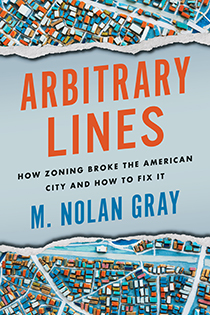An excerpt from the latest book on zoning argues for four approaches to reform that can immediately improve land use regulation in the United States.

Planetizen is pleased to present this excerpt from Arbitrary Lines: How Zoning Broke the American City and How to Fix It, authored by M. Nolan Gray and published this month by Island Press.
The excerpt, which opens Part III of the book, titled “Toward a Less Bad Zoning,” list four reforms that the author argues will make immediate progress toward ending the ongoing cycle of damage caused by zoning to the economy, the environment, and the social fabric of the United States. [Ed’s note: Blue links are from the book’s footnotes. Underlined links are automatically generated to connect to Planopedia.]
The Low-Hanging Fruit of Local Reform
For better or worse, local governments now determine most zoning policy in the US. While states and the federal government have an important role to play, local governments are nonetheless best positioned to reform zoning today. There are at least four zoning reforms that cities and suburbs must embrace: ending single-family zoning, abolishing minimum parking requirements, eliminating or lowering minimum floor area and minimum lot size requirements, and decriminalizing inherently affordable housing typologies. Let’s dig into each of these reforms in turn.
END SINGLE-FAMILY ZONING
 Single-family zoning forbids the construction of anything more than a detached single-family house on any given lot, such that duplexes, fourplexes, and larger apartment buildings are outright banned, a theme we discussed back in chapter 3. In a typical US city, at least three-quarters of the land zoned for residential uses will be zoned exclusively for single-family houses. In suburbs, this share can easily rise to 100 percent, allowing municipalities to effectively ban one of the most affordable forms of housing.
Single-family zoning forbids the construction of anything more than a detached single-family house on any given lot, such that duplexes, fourplexes, and larger apartment buildings are outright banned, a theme we discussed back in chapter 3. In a typical US city, at least three-quarters of the land zoned for residential uses will be zoned exclusively for single-family houses. In suburbs, this share can easily rise to 100 percent, allowing municipalities to effectively ban one of the most affordable forms of housing.
Needless to say, single-family zoning is a major hurdle to new affordable housing construction, as density is how less affluent residents outbid the rich for land. Imagine you own a four-thousand-square-foot house. You have two potential buyers: the first buyer intends to occupy it as a single-family house and can afford to pay $300,000. The second buyer intends to subdivide the home into four one-thousand-square-foot units renting at a modest market rate of $500 each. Assuming standard expenses and a 6 percent cap rate, this second buyer can afford to pay you $336,000. Who do you sell to? You don’t need to be a bleeding-heart housing activist to go with the option that will entail more affordable housing.
Before zoning, this process of incremental housing growth played out over and over again in every American city. Single-family houses weren’t the final word, as they are under zoning, but merely the first step. As demand grew, houses were divided into duplexes and fourplexes, turning mansions into apartments. By economizing on land and putting more housing units on the same plot, even working-class Americans were able to outbid the wealthy for mansions, thereby incrementally increasing the housing supply. Yet under zoning, creating this type of low-rise multi-family housing—often within walking distance of transit and commercial uses—is nearly always illegal.
As mentioned earlier, not every city is sitting on its hands when it comes to single-family zoning. In 2018, Minneapolis became the first city to abolish single-family zoning. Like many American cities, Minneapolis had until recently zoned 70 percent of its land exclusively for single-family housing, with disastrous downstream implications for housing affordability and racial and economic segregation. Under the leadership of councilmember Lisa Bender and with support from Neighbors for More Neighbors, a local YIMBY group, the Minneapolis City Council voted twelve to one to abolish single-family zoning as part of its 2040 comprehensive plan overhaul, which by Minnesota law triggers associated changes in the zoning code. Duplexes and triplexes are now allowed in residential areas citywide.
Another tactic that cities have taken in phasing out single-family zoning has been to adopt liberal accessory dwelling unit (ADU) ordinances. Though single-family districts may remain on the zoning map, a liberal ADU ordinance offers a backdoor way to eliminate single-family zoning, namely by allowing extra housing units to go in the unused bedrooms, basements, attics, and garages of single-family houses. Cheap and easy to build, ADUs offer a politically expedient way to create inherently affordable housing in what are often affluent neighborhoods. As a side benefit, ADUs also allow homeowners to earn additional income by subdividing their homes and collecting rent.
A testament to their salience as a political compromise for adding new housing in existing single-family neighborhoods, ADU ordinances have grown in popularity across the country, with ordinances sprouting up in cities as diverse as Somerville, Massachusetts, and Gainesville, Florida. But getting the rules right is important: in many cases, cities adopt excessively strict rules surrounding ADUs, resulting in few units being built.
In 2018, Fayetteville, Arkansas, recognized as much when it amended its ADU ordinance to scrap an ADU owner-occupancy requirement—which required that property owners live in the primary unit—and eliminated the off-street parking requirements for new units, among other reforms. At the same time, the city changed the rules to now allow one attached ADU and one interior ADU on every residential lot, such that Fayetteville now effectively enjoys citywide triplex zoning. While not as sexy as outright abolishing single-family zoning, the spread of ADUs constitutes meaningful progress.
Another necessary reform is the elimination of minimum parking requirements, a theme we discussed back in chapter 6. These rules stipulate that for every so many residential units or square feet of commercial or industrial use a developer builds, they must also build so many off-street parking spaces. Cities initially adopted these rules to deal with the high demand for on-street parking. But these rules have many harmful side effects. For starters, they increase housing costs by forcing developers to build surface lots or parking garages, which require a lot of additional land and capital. They also presuppose that all development will be auto oriented, regardless of whether the actual residents, patrons, or employees arrive by car, privileging sprawl over traditional walkable patterns of development.
The ideal path for reform-minded cities is to follow the formula set out by economist and parking policy guru Donald Shoup: correctly price the on-street parking and let developers determine how much off-street parking, if any, is necessary for each development. By applying dynamic prices to street parking, in which prices shift in response to demand, cities can ensure that there will always be a few spots available, thereby reducing the incentive to cruise for an unpriced space. As a side benefit, Shoup notes, this would open up a new source of revenue for communities, funding local street improvements and street upgrades.
As far as off-street parking goes, developers—not planners—have both the right incentives and local knowledge needed to determine how much off-street parking is necessary. After all, if a developer builds too much parking, they waste money, while if they build too little, they may have trouble selling or leasing out the space. Eliminating minimum parking requirements merely gives developers the flexibility needed to adjust the amount of parking to local conditions, perhaps building more in suburban areas and less in more urban areas. As more and more cities and towns are looking to clear a path for infill development, minimum parking requirements have often been the first zoning rules to go. In 2017, Buffalo became the first major US city to abolish parking requirements, quickly followed by Hartford. Innumerable suburbs and small towns, along with big cities like San Francisco and Minneapolis, soon followed. Where minimum parking requirements linger, they have often been substantially reduced. Over the past ten years, cities like San Diego and Cincinnati have substantially reduced these requirements, often outright eliminating them near transit and in central business districts. While there’s still a long way to go in eliminating this element of zoning, important progress is being made.
ELIMINATE OR LOWER MINIMUM LOT SIZE AND FLOOR AREA REGULATIONS
Another reform that is gaining traction is to lower or eliminate minimum floor area and lot size regulations. Minimum floor area requirements prohibit the construction of an apartment or home below some specified square footage. These rules will vary by zoning district. For example, in Des Moines, a single-story house cannot be smaller than 1,300 to 1,700 square feet—depending on the design and location—regardless of what prospective residents may prefer. While cities often set minimum floor area rules for apartments, a common variation of this rule is to limit the number of apartments that may be in a given building based on its floor area. In New York City, for example, this is referred to as the dwelling unit factor, which in more liberal districts requires 680 square feet of floor area per apartment.
Similarly, minimum lot size requirements stipulate the amount of land that must be set aside for each house. Returning to Des Moines, the minimum lot size for detached single-family homes hovers between 7,500 and 10,000 square feet. Many municipalities may also define a maximum number of units per acre, but the effect is the same, in that it requires that some minimum amount of land be consumed per house built. Both minimum floor area and lot size rules can range much higher than these examples might imply. In New York City, for example, the effective minimum size of an apartment in certain districts can be as high as 1,560 square feet, while in suburban New England, minimum lot sizes often run well over two acres.
It’s important to note that these rules have no basis in health or safety requirements. Minimum unit sizes, as determined by the actual building code, are often far smaller than zoning’s minimum floor area requirements. The purpose of these zoning rules is merely to force houses and the lots they sit on to be bigger than they might otherwise have been. This, in turn, raises housing costs, providing local policymakers with a subtle way of excluding less affluent residents by way of setting high minimums. The development pattern that results from these policies—a landscape of McMansions on Potemkin estates—is also the groundwork for American sprawl.
Unlike single-family zoning or minimum parking requirements, uptake on minimum floor area and lot size reform has been underwhelming. This is too bad, as reforming these two rules would likely have a profound impact on American development patterns: for cities and towns along the coasts, scrapping minimum floor area requirements would allow the market to meet the burgeoning demand for “microunits” and “tiny houses,” which can be as small as 280 square feet. And in the suburbs of the Sun Belt and Mountain West, where the overwhelming majority of US housing growth is now happening, lowering minimum lot sizes would result in more housing, less segregation, and less sprawl as cities expand outward.
DECRIMINALIZE INHERENTLY AFFORDABLE HOUSING TYPOLOGIES
Beyond these “low-hanging fruit” reforms, there are several important zoning reforms that have yet to make the transition from policy paper to reality. Key among them is the need for cities to remove barriers to new housing construction at the bottom of the market. As discussed earlier in this book, single-room occupancies (SROs)—which allow a resident to lease a private bedroom with a shared bathroom and kitchen—historically served as an invaluable source of affordable housing at the bottom of the market. Indeed, SROs kept millions of Americans off the street. Yet new SROs are nearly always banned by zoning. Policymakers could change that tomorrow.
In the same spirit, municipalities—particularly suburbs and rural areas—should end zoning discrimination against manufactured housing. Once synonymous with “cheap,” manufactured housing today is often just as good as site-built housing, both from an energy efficiency and a durability standpoint, yet at around a third of the cost. After the initial manufactured housing boom of the 1970s, many municipalities in warm-weather states like Florida quickly clamped down on manufactured housing by way of zoning, for no other reason than to exclude less affluent residents. As with bans on SROs, zoning bans on manufactured housing mainly serve to criminalize the bottom of the housing market, while giving exclusionary suburbs another tool to keep the less affluent out of their communities. Both rules should go.
Arbitrary Lines: How Zoning Broke the American City and How to Fix It
M. Nolan Gray
June 2022
Island Press
256 Pages
M. Nolan Gray is a professional city planner and an expert in urban land-use regulation. He is currently completing a Ph.D. in urban planning at the University of California, Los Angeles. Gray previously worked on the front lines of zoning as a planner in New York City. He now serves as an Affiliated Scholar with the Mercatus Center at George Mason University, where he advises state and local policymakers on land-use policy. Gray is a contributor to Market Urbanism and a widely published author, with work appearing in outlets such as The Atlantic, Bloomberg Citylab, and The Guardian. He lives in Los Angeles, California and is originally from Lexington, Kentucky.

Maui's Vacation Rental Debate Turns Ugly
Verbal attacks, misinformation campaigns and fistfights plague a high-stakes debate to convert thousands of vacation rentals into long-term housing.

Planetizen Federal Action Tracker
A weekly monitor of how Trump’s orders and actions are impacting planners and planning in America.

San Francisco Suspends Traffic Calming Amidst Record Deaths
Citing “a challenging fiscal landscape,” the city will cease the program on the heels of 42 traffic deaths, including 24 pedestrians.

Defunct Pittsburgh Power Plant to Become Residential Tower
A decommissioned steam heat plant will be redeveloped into almost 100 affordable housing units.

Trump Prompts Restructuring of Transportation Research Board in “Unprecedented Overreach”
The TRB has eliminated more than half of its committees including those focused on climate, equity, and cities.

Amtrak Rolls Out New Orleans to Alabama “Mardi Gras” Train
The new service will operate morning and evening departures between Mobile and New Orleans.
Urban Design for Planners 1: Software Tools
This six-course series explores essential urban design concepts using open source software and equips planners with the tools they need to participate fully in the urban design process.
Planning for Universal Design
Learn the tools for implementing Universal Design in planning regulations.
Heyer Gruel & Associates PA
JM Goldson LLC
Custer County Colorado
City of Camden Redevelopment Agency
City of Astoria
Transportation Research & Education Center (TREC) at Portland State University
Jefferson Parish Government
Camden Redevelopment Agency
City of Claremont





























